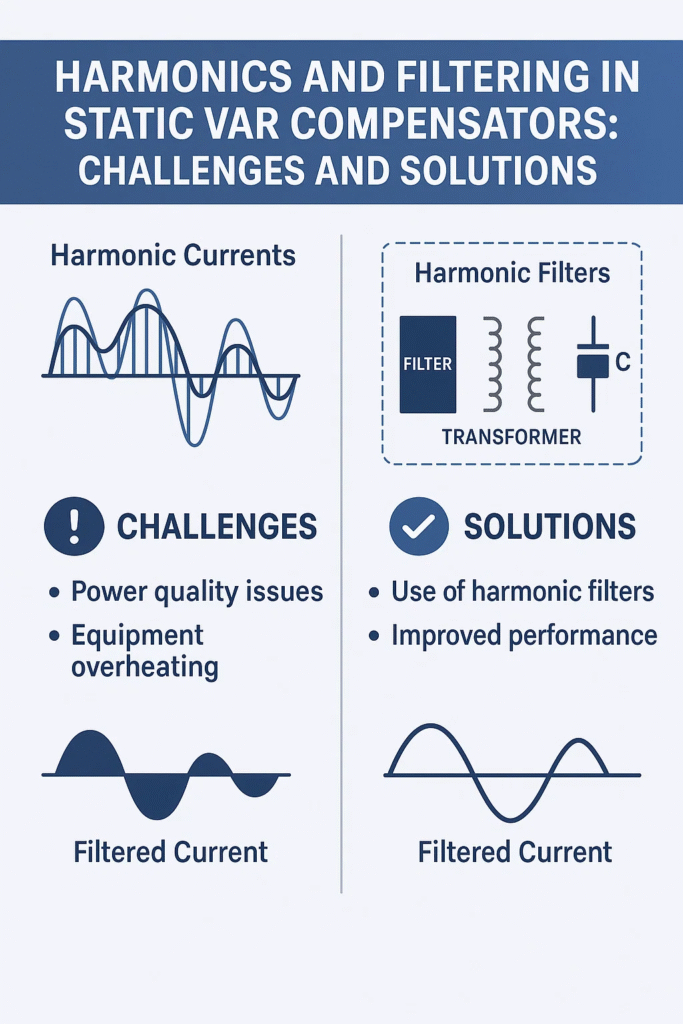⚡ Introduction
In today’s evolving power systems, Static Var Compensators (SVCs) play a key role in regulating voltage, improving power factor, and enhancing overall system stability. However, one of the major side effects of incorporating power electronics into the grid is the generation of harmonics. Harmonics, if left unmitigated, can degrade power quality, reduce the lifespan of equipment, and compromise the performance of the power system.
The integration of thyristor-controlled reactors (TCRs) and other nonlinear components in SVCs makes them significant sources of harmonic distortion. Consequently, designing effective harmonic filtering systems becomes essential for the safe and efficient operation of SVCs. This blog explores the sources of harmonics in SVCs, their impact, filtering techniques, and modern strategies to combat these challenges.
🎛️ What Are Harmonics?
Harmonics are voltage or current waveforms whose frequencies are integer multiples of the fundamental power system frequency (50 Hz or 60 Hz). For example:
- 2nd harmonic = 100 Hz
- 3rd harmonic = 150 Hz
- 5th harmonic = 250 Hz
While the power system is designed to operate at a pure sinusoidal frequency, nonlinear loads like SVCs introduce distorted waveforms with these higher-frequency components, leading to multiple operational issues.

🚧 Sources of Harmonics in SVCs
The key harmonic-generating element in an SVC is the Thyristor-Controlled Reactor (TCR). Here’s why:
- TCRs operate by partially conducting sinusoidal current, controlled via the thyristor firing angle.
- This nonlinear operation chops the current waveform, creating harmonic components.
- While Thyristor-Switched Capacitors (TSCs) are also part of the SVC, they typically contribute fewer harmonics because they switch on and off at zero crossings.
Common Harmonics Produced:
- The 5th, 7th, 11th, and 13th harmonics are most dominant.
- Even harmonics (2nd, 4th, etc.) are generally low in a balanced system.
- Interharmonics can occur due to timing variations and switching transients.
📉 Impact of Harmonics on the Power System
Unchecked harmonics can have serious consequences on the electrical network and connected equipment:
- Overheating of transformers, motors, and cables
- False tripping of protective relays and circuit breakers
- Increased losses and reduced efficiency
- Malfunctioning of sensitive electronics
- Amplification of resonance in power networks
- Degradation of capacitor banks and insulation systems
For utilities and industrial users, harmonics mean higher maintenance costs, equipment damage, and compliance issues with power quality standards like IEEE 519.
🧰 Harmonic Filtering in SVCs
To control harmonic emissions, SVCs are equipped with specially designed passive harmonic filters. These filters are tuned to absorb specific harmonic frequencies and prevent them from propagating into the network.
🔸 Types of Filters:
- Single-Tuned (Band-Pass) Filters
- Designed to target a specific harmonic order (e.g., 5th or 7th).
- Built with inductors and capacitors in a resonant configuration.
- Provide high impedance at all frequencies except the tuned harmonic.
- High-Pass Filters
- Attenuate a wide range of higher-order harmonics.
- Offer broadband filtering and are typically connected in parallel with tuned filters.
- C-Type Filters
- A variation of single-tuned filters with improved reactive power characteristics.
- Ideal for networks with fluctuating loads.
- Damped Filters
- Include resistive components to provide broader filtering and minimize resonance.
⚙️ Design Considerations for SVC Filters
Designing harmonic filters involves balancing performance, cost, and space. Key factors include:
- Target harmonic orders (based on SVC operating range)
- Total harmonic distortion (THD) limits
- Reactive power requirements of the system
- Avoidance of resonance with system impedances
- Load variability and switching frequency
- Power quality compliance standards
Engineers often use harmonic studies and simulation tools to model system behavior and optimize filter design.
🚀 Advanced Harmonic Mitigation Strategies
As SVCs become more sophisticated, so do the harmonic mitigation methods:
- Hybrid Filter Systems
- Combine passive filters with active harmonic filters that inject anti-harmonic currents in real time.
- Offer better dynamic response and adaptability.
- Digital Control Techniques
- Advanced control algorithms dynamically adjust SVC operation to minimize harmonic generation.
- Phase-locked loops (PLLs) and harmonic detection algorithms improve accuracy.
- Improved Thyristor Firing Logic
- Better timing control reduces waveform distortion.
- Selective harmonic cancellation can be implemented through optimized switching patterns.
- Modular Multilevel Converters (MMC)
- Used in modern SVC+ systems.
- Significantly reduce harmonic generation by producing near-sinusoidal waveforms.
📊 Monitoring and Compliance
Harmonic monitoring is now an integral part of SVC operation:
- Power quality meters constantly track Total Harmonic Distortion (THD)
- SCADA integration allows for real-time alerts and diagnostics
- Regular audits ensure compliance with standards such as:
- IEEE 519
- IEC 61000-4-7
- EN 50160
Utilities may impose fines or restrictions on systems that exceed harmonic limits, making continuous monitoring essential.
✅ Conclusion
While Static Var Compensators greatly enhance voltage stability and reactive power control in modern electrical systems, their operation inherently generates harmonics due to the non-linear behavior of thyristor-controlled devices. These harmonics can degrade power quality, affect system performance, and shorten equipment life if not addressed.
To combat these challenges, engineered harmonic filters, smart control techniques, and advanced monitoring tools are employed as part of a comprehensive mitigation strategy. Understanding the sources, effects, and solutions related to harmonics in SVCs is critical for both designers and operators seeking to maintain grid reliability and meet regulatory standards.
As power systems continue to evolve and integrate renewable energy and flexible AC transmission systems (FACTS), harmonic management in SVCs will remain a cornerstone of modern power quality engineering.
